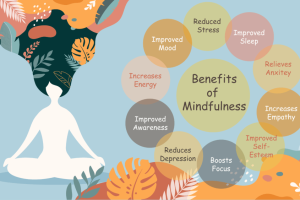Mindfulness Matters: Cultivating a Healthy Lifestyle

Understanding Mindfulness
Mindfulness is often described as the simple act of being present. It’s about actively engaging with the moment rather than being lost in thought or distracted by the chaos of life. Imagine sipping a warm cup of tea. Mindfulness encourages savoring each sip, noticing the warmth of the cup, the aroma of the tea, and the gentle steam rising. This practice cultivates an awareness that can enhance daily experiences and contribute positively to overall well-being.
- Mindfulness Matters: Cultivating a Healthy Lifestyle
- Understanding Mindfulness
- Benefits of a Healthy Lifestyle
- The Connection Between Mindfulness and Physical Health
- Mindful Eating
- Mindful Exercise
- The Impact of Mindfulness on Mental Health
- Stress Reduction
- Improved Emotional Well-being
- Practicing Mindfulness in Daily Life
- Mindful Breathing Techniques
- Mindful Time Management Strategies
- Cultivating Healthy Relationships through Mindfulness
- Communicating Mindfully
- Building Empathy and Compassion
- Mindfulness in the Workplace
- Enhancing Focus and Productivity
- Managing Stress at Work
- Mindfulness and Sleep
- Improving Sleep Quality
- Mindful Bedtime Routines
- Mindfulness for Overall Well-being
- Finding Balance in Life
- Mindful Self-care Practices
Benefits of a Healthy Lifestyle
Living a healthy lifestyle goes hand in hand with mindfulness. The benefits are profound and multidimensional, affecting both physical and mental health. Here are some notable advantages:
- Improved Physical Health: Regular exercise and a balanced diet can lead to a stronger immune system and a lower risk of chronic illnesses.
- Better Mental Clarity: A nutritious diet fuels the brain, enhancing focus and cognitive abilities.
- Increased Energy Levels: Healthy choices contribute to sustained energy throughout the day.
By understanding mindfulness and embracing a healthy lifestyle, one can achieve a harmonious balance that enriches both mind and body. This connection sets the stage for exploring the intricate relationship between mindfulness and physical health, which will be our next focus.
The Connection Between Mindfulness and Physical Health
Mindful Eating
Mindful eating is a wonderful approach that encourages individuals to pay full attention to their food. It’s not just about what you eat but how you eat it. Instead of hurriedly consuming a meal while scrolling through a phone, mindfulness invites you to engage your senses. Consider these key elements of mindful eating:
- Savoring the Flavors: Take time to enjoy each bite, noticing the flavors and textures. This can lead to a more satisfying experience and prevent overeating.
- Listening to Your Body: Tune in to hunger and fullness cues. Ask yourself whether you are eating out of hunger or habit.
Imagine enjoying a juicy slice of watermelon on a hot day. You can appreciate the sweetness and juiciness, savoring every moment.
Mindful Exercise
Just as mindful eating enhances your relationship with food, mindful exercise transforms the way you engage in physical activity. Instead of viewing exercise as a chore, mindfulness encourages a more holistic approach. Here are some mindfulness strategies for exercise:
- Focus on Your Breath: Pay attention to your breathing as you move. This can help ground you in the present moment.
- Enjoy the Movement: Whether it’s yoga, running, or dancing, find joy in the activity itself.
By integrating mindfulness into eating and exercise, you can unlock a deeper appreciation for both your body and your health. The transition into navigating the impact of mindfulness on mental health is next on our journey.
The Impact of Mindfulness on Mental Health
Stress Reduction
Transitioning from the physical benefits of mindfulness, it’s evident that this practice also plays a significant role in mental health, particularly in stress reduction. Life’s demands can often feel overwhelming, but mindfulness can act as a powerful antidote. Here’s how it helps:
- Awareness of Stress Triggers: By cultivating mindfulness, individuals can identify what triggers their stress. This awareness allows for proactive management rather than reactive responses.
- Grounding Techniques: Engaging in mindful breathing or meditation can anchor one back to the present moment, providing relief from overwhelming thoughts.
Picture this: after a long day, taking just five minutes to focus on breathing can transform your state of mind, allowing you to reset.
Improved Emotional Well-being
Mindfulness doesn’t just reduce stress; it also fosters improved emotional well-being. It allows individuals to experience emotions without judgment, increasing emotional resilience and stability. Consider these benefits:
- Enhanced Self-awareness: Mindfulness encourages reflection on one’s thoughts and feelings, leading to greater self-acceptance and understanding.
- Better Coping Strategies: Mindful practices equip individuals with tools to handle emotional challenges effectively.
For instance, a friend once shared how practicing mindfulness during tough times helped her navigate through heartache, allowing her to feel her emotions without becoming overwhelmed. As we explore the powerful effects of mindfulness further, we will delve into its practical application in daily life.
Practicing Mindfulness in Daily Life
Mindful Breathing Techniques
Continuing on our journey of mindfulness, one of the most effective and accessible practices is mindful breathing. This simple technique can be seamlessly integrated into daily life, offering a quick escape from stress and anxiety. To practice mindful breathing, try these steps:
- Find a Comfortable Position: Sit or lie down in a quiet space where you won’t be disturbed.
- Focus on Your Breath: Close your eyes and take a deep breath in through your nose, allowing your belly to expand fully. Exhale slowly through your mouth, feeling the tension leave your body.
- Count Your Breaths: Inhale for a count of four, hold for four, and exhale for four. Repeat this cycle for a few minutes.
A personal tip: during particularly busy days, I take a minute in between tasks to practice this technique. It always helps me refocus and recharge.
Mindful Time Management Strategies
Effective time management is another area where mindfulness can create significant improvements. Instead of rushing through your day, consider adopting these mindful strategies:
- Prioritize Tasks: Create a to-do list and highlight the most important items. This helps in focusing your energy where it’s most needed.
- Set Time Blocks: Allocate specific time slots for tasks and take short breaks in between. This includes moments for mindfulness exercises, ensuring you stay grounded throughout the day.
By embracing these mindful strategies, individuals can cultivate a more intentional approach to their time, leading to greater productivity and less overwhelm. As we shift our focus towards relationships, let’s explore how mindfulness can enhance our connections with others.
Cultivating Healthy Relationships through Mindfulness
Communicating Mindfully
Transitioning from personal management to our connections with others, mindfulness plays a crucial role in cultivating healthy relationships. One of the cornerstones of such relationships is mindful communication. This involves being genuinely present during conversations and actively listening to understand rather than merely respond. Here are some effective strategies:
- Active Listening: Rather than thinking about your response while the other person is speaking, focus on what they are saying. Nod, maintain eye contact, and ask clarifying questions.
- Pause Before Responding: Take a moment to process what has been said before replying. This creates space for thoughtful responses instead of knee-jerk reactions.
I recall a time when I practiced this during a disagreement with a friend. By listening fully and pausing before reacting, we found common ground and resolved our conflict peacefully.
Building Empathy and Compassion
Mindfulness can also enhance empathy and compassion, essential components of healthy relationships. When individuals engage in mindfulness practices, they become more attuned to their emotions and the feelings of others. Consider these approaches:
- Perspective-Taking: Try to see situations from others’ perspectives, which fosters understanding and lessens judgment.
- Compassion Exercises: Practice wishing well for others, even those you might disagree with. This promotes a sense of connection and reduces animosity.
For instance, reflecting on a challenging interaction with a co-worker helped me develop compassion towards their struggles, leading to a more harmonious work environment. As we explore mindfulness further, let’s assess its impact in professional settings, particularly at work.
Mindfulness in the Workplace
Enhancing Focus and Productivity
Transitioning from personal relationships, mindfulness is equally transformative in professional settings. In today’s fast-paced work environment, maintaining focus and productivity can be a challenge. Mindfulness practices, however, provide valuable tools to improve concentration. Consider these techniques to enhance focus:
- Daily Mindfulness Breaks: Incorporate short breaks throughout your day to practice mindful breathing or simply step away from your desk. This refreshes your mind and sharpens your focus when you return to work.
- Set Intentions: At the start of each day, take a few minutes to outline your primary goals. This intention-setting helps channel your energy towards accomplishing specific tasks.
I remember implementing a midday pause at work for a brief mindfulness session; it significantly boosted my afternoon productivity and creativity.
Managing Stress at Work
Incorporating mindfulness also plays a crucial role in managing workplace stress. The demands of deadlines and high expectations can easily lead to overwhelm. Here’s how mindfulness can help:
- Mindful Task Management: Prioritize tasks and concentrate on one project at a time, which reduces the feeling of being overwhelmed by your to-do list.
- Awareness of Stress Responses: Recognizing signs of stress in the body, such as tension or fatigue, allows for timely interventions like stretching or deep breathing.
By adopting these practices, individuals can create a healthier work environment, leading to reduced burnout and improved overall satisfaction. Next, we will explore how mindfulness can enhance sleep quality and bedtime routines.
Mindfulness and Sleep
Improving Sleep Quality
As we shift focus from workplace practices, it’s essential to recognize the role of mindfulness in improving sleep quality. For many, a good night’s sleep feels elusive, yet mindfulness can create a path to restful slumber. Here’s how mindfulness can enhance sleep:
- Reduce Racing Thoughts: Engaging in mindfulness helps calm an active mind. Techniques like meditation or deep breathing can ease worries, making it easier to drift off.
- Body Scan Exercises: Before bed, practice a body scan, mentally checking in on each part of your body. This relaxes tension and promotes a state of calm.
I found that incorporating a short meditation routine before sleep significantly improved my restfulness, allowing me to wake up feeling rejuvenated.
Mindful Bedtime Routines
Establishing a mindful bedtime routine can also be transformative. Creating a calming environment signals to your body that it’s time for rest. Consider these elements for an effective routine:
- Technology Detox: An hour before bed, put away screens. Engage in activities like reading or gentle stretching instead.
- Create a Relaxing Atmosphere: Dim the lights, play soothing music, or light some candles. This sets a tranquil tone for wind-down time.
Implementing these mindful practices can lead to improved sleep hygiene, fostering overall well-being. As we conclude this journey, let’s reflect on the broader implications of mindfulness for achieving overall well-being in life.
Mindfulness for Overall Well-being
Finding Balance in Life
Having explored mindfulness’s impact on sleep, we now arrive at its essential role in achieving overall well-being. In our fast-paced world, finding balance can feel overwhelming, but mindfulness offers tools to navigate life’s demands more gracefully. Here are some strategies to cultivate balance:
- Set Boundaries: Learn to say no to activities that drain your energy. Protecting your time allows for self-care and time with loved ones.
- Practice Gratitude: Regularly reflecting on what you are thankful for can shift your focus from stressors to the positive aspects of life.
For me, creating a gratitude journal has become a nightly ritual that enhances my outlook on life, reminding me of the beauty in everyday moments.
Mindful Self-care Practices
Self-care is paramount when it comes to well-being, and mindfulness can elevate these practices. Engaging in activities that nurture your soul can make a world of difference. Consider these mindful self-care practices:
- Engage in Creative Hobbies: Whether painting, gardening, or writing, allow yourself to indulge in activities that bring you joy.
- Mindful Movement: Try yoga or tai chi, which combine physical activity with mindfulness for holistic wellness.
By integrating mindfulness into self-care routines, individuals can foster a deeper sense of fulfillment and vitality. Embracing these practices ultimately leads to a more balanced and enriched life. Mindfulness is indeed a journey that enhances every aspect of living, and taking small steps can culminate in significant positive changes.





